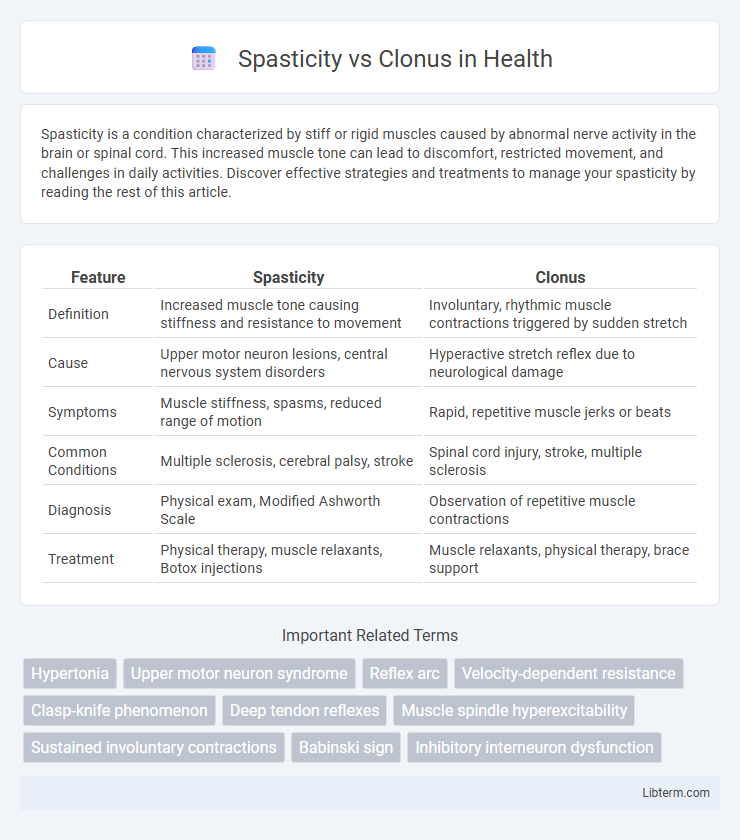Spasticity is a condition characterized by stiff or rigid muscles caused by abnormal nerve activity in the brain or spinal cord. This increased muscle tone can lead to discomfort, restricted movement, and challenges in daily activities. Discover effective strategies and treatments to manage your spasticity by reading the rest of this article.
Table of Comparison
| Feature | Spasticity | Clonus |
|---|---|---|
| Definition | Increased muscle tone causing stiffness and resistance to movement | Involuntary, rhythmic muscle contractions triggered by sudden stretch |
| Cause | Upper motor neuron lesions, central nervous system disorders | Hyperactive stretch reflex due to neurological damage |
| Symptoms | Muscle stiffness, spasms, reduced range of motion | Rapid, repetitive muscle jerks or beats |
| Common Conditions | Multiple sclerosis, cerebral palsy, stroke | Spinal cord injury, stroke, multiple sclerosis |
| Diagnosis | Physical exam, Modified Ashworth Scale | Observation of repetitive muscle contractions |
| Treatment | Physical therapy, muscle relaxants, Botox injections | Muscle relaxants, physical therapy, brace support |
Introduction to Spasticity and Clonus
Spasticity is a condition characterized by an abnormal increase in muscle tone or stiffness, often resulting from damage to the central nervous system such as stroke, multiple sclerosis, or cerebral palsy. Clonus refers to a series of involuntary, rhythmic muscle contractions and relaxations, typically triggered by sudden muscle stretch and frequently observed in patients with spasticity. Understanding the distinction between spasticity and clonus is crucial for accurate diagnosis and effective management of neuromuscular disorders.
Defining Spasticity: Key Features
Spasticity is characterized by a velocity-dependent increase in muscle tone, resulting from hyperactive stretch reflexes due to upper motor neuron lesions. This condition leads to stiffness and resistance to passive movement, primarily affecting flexor or extensor muscle groups. Key features distinguishing spasticity include increased tendon reflexes, muscle hypertonia, and muscle spasms, which contrast with the rhythmic, involuntary muscle contractions seen in clonus.
Understanding Clonus: An Overview
Clonus is a neurological condition characterized by involuntary, rhythmic muscle contractions typically triggered by sudden muscle stretch. It differs from spasticity, which involves continuous muscle stiffness and increased tone, by producing rapid, repetitive jerks rather than sustained muscle tightness. Understanding clonus involves recognizing its association with upper motor neuron lesions, its diagnostic significance in conditions like multiple sclerosis and stroke, and its impact on motor control and patient mobility.
Causes and Underlying Mechanisms
Spasticity arises from upper motor neuron lesions that disrupt inhibitory signals in the central nervous system, leading to increased muscle tone and exaggerated stretch reflexes. Clonus is caused by hyperactive spinal reflex arcs and repetitive muscle contractions triggered by sudden muscle stretch or sustained stretch, often resulting from similar upper motor neuron damage. Both conditions reflect altered neural control but differ in their manifestations, with spasticity involving sustained muscle tightness and clonus characterized by rhythmic, involuntary muscle contractions.
Clinical Presentations and Symptoms
Spasticity presents as a velocity-dependent increase in muscle tone causing stiffness and resistance to passive movement, often accompanied by hyperreflexia and muscle weakness. Clonus is characterized by rhythmic, involuntary muscle contractions triggered by sudden stretch or sustained muscle stretch, commonly seen in the ankle or wrist. Both conditions result from upper motor neuron lesions but differ in clinical manifestations, with spasticity involving continuous muscle tightness and clonus featuring repetitive, oscillatory movements.
Diagnostic Criteria and Assessment
Spasticity is characterized by velocity-dependent increased muscle tone and hyperactive stretch reflexes, whereas clonus presents as rhythmic, involuntary muscle contractions triggered by sudden muscle stretch. Diagnostic criteria for spasticity include assessing resistance to passive movement at varying speeds and evaluating exaggerated tendon reflexes using scales like the Modified Ashworth Scale. Clonus assessment involves eliciting sustained rhythmic oscillations through rapid dorsiflexion of the ankle or quick wrist flexion, with the duration and frequency of clonic beats used as key quantifiable markers.
Differences Between Spasticity and Clonus
Spasticity is a velocity-dependent increase in muscle tone causing resistance to passive movement, while clonus is characterized by rhythmic, involuntary muscle contractions triggered by sudden stretching. Spasticity results from upper motor neuron lesions leading to hyperactive stretch reflexes, whereas clonus manifests as repetitive muscle contractions due to sustained reflex hyperexcitability. Clinically, spasticity presents as a continuous stiffness affecting muscle control, in contrast to clonus, which appears as repetitive jerking movements often observed in ankle dorsiflexion or wrist extension.
Common Conditions Associated with Each
Spasticity is commonly associated with neurological disorders such as multiple sclerosis, cerebral palsy, and stroke, characterized by increased muscle tone and exaggerated tendon reflexes. Clonus frequently occurs in conditions like spinal cord injury, traumatic brain injury, and amyotrophic lateral sclerosis (ALS), presenting as rhythmic, involuntary muscle contractions due to hyperactive stretch reflexes. Both phenomena often indicate upper motor neuron lesions, but their presence helps differentiate specific underlying pathologies and guides targeted therapeutic interventions.
Treatment and Management Strategies
Spasticity treatment involves therapies such as physical rehabilitation, oral muscle relaxants like baclofen, and botulinum toxin injections to reduce muscle stiffness and improve mobility. Clonus management focuses on controlling the underlying neurological disorder with anticonvulsants, muscle relaxants, and targeted physiotherapy to minimize repetitive muscle contractions. Both conditions benefit from individualized multidisciplinary approaches including occupational therapy and assistive devices to enhance functional independence.
Prognosis and Long-term Outlook
Spasticity often results from upper motor neuron lesions and can lead to muscle stiffness and impaired movement control, with prognosis varying based on the severity and underlying cause such as stroke or cerebral palsy. Clonus, characterized by rhythmic muscle contractions, typically indicates severe neurological impairment and may signal more significant long-term motor dysfunction, especially in conditions like multiple sclerosis or spinal cord injury. Long-term management of both spasticity and clonus involves targeted therapies including physical rehabilitation, pharmacological treatments like baclofen or botulinum toxin, and sometimes surgical interventions to improve functional outcomes and quality of life.
Spasticity Infographic

 libterm.com
libterm.com